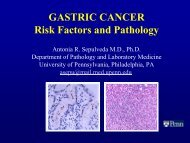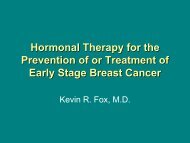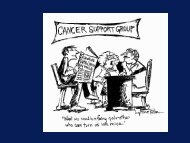Medical Management of Colorectal Cancer - Abramson Cancer Center
Medical Management of Colorectal Cancer - Abramson Cancer Center
Medical Management of Colorectal Cancer - Abramson Cancer Center
You also want an ePaper? Increase the reach of your titles
YUMPU automatically turns print PDFs into web optimized ePapers that Google loves.
<strong>Medical</strong> <strong>Management</strong> <strong>of</strong><strong>Colorectal</strong> <strong>Cancer</strong>Bruce J. Giantonio, MD
The Good News• More people with early disease can be cured:- Improved adjuvant therapy• People with advanced disease live longer withtreatment:- 4-5 times longer than NO treatment- YEARS instead <strong>of</strong> MONTHS• Many new therapies currently in clinical trials
The Bad News• Few people undergo screening• Not all people with advanced disease benefitfrom treatment- Need to further refine our ability to ‘tailor’ treatmentbased on risk• Only 2-3% <strong>of</strong> adults with cancer in the USparticipate in clinical trials• Side effects remain a problem
Stage at Diagnosis2008 new cases:colon cancer: 108,070rectal cancer: 40,7403 rd leading cancer diagnosis2 nd leading cause <strong>of</strong> cancer death21% Stage IV14% Stage I37% Stage III28% Stage II<strong>Cancer</strong> Statistics: Jemal et al; CA <strong>Cancer</strong> J Clin 2008
Staging <strong>of</strong> <strong>Colorectal</strong> <strong>Cancer</strong>STAGE:1 2 3INSIDE orLUMENMUCOSAMUSCULARIS MUCOSASUBMUCOSAWALLUSCULARIS PROPRIASEROSAFATLYMPH NODESOUTSIDEAdapted from Skarin. Slide Atlas <strong>of</strong> Diagnostic Oncology. Gower <strong>Medical</strong> Publishing; 1997:Fig 5.98.
Colon <strong>Cancer</strong> TreatmentStage ISURGERYStage IV21%Stage I14%Stage III37%Stage II28%<strong>Cancer</strong> Statistics: Jemal et al; CA <strong>Cancer</strong> J Clin 2005;55:10-30
Colon <strong>Cancer</strong> TreatmentStage ISURGERYStage IV21%Stage I14%Stage III37%Stage II28%Stage IISURGERY+/- chemo<strong>Cancer</strong> Statistics: Jemal et al; CA <strong>Cancer</strong> J Clin 2005;55:10-30
Colon <strong>Cancer</strong> TreatmentStage ISURGERYStage IV21%Stage I14%Stage IIIStage III37%SURGERY →chemotherapyStage IISURGERY+/- chemoStage II28%<strong>Cancer</strong> Statistics: Jemal et al; CA <strong>Cancer</strong> J Clin 2005;55:10-30
Colon <strong>Cancer</strong> TreatmentStage IVCHEMOTHERAPY+/- surgeryStage IV21%Stage ISURGERYStage I14%Stage IIIStage III37%SURGERY →chemotherapyStage IISURGERY+/- chemoStage II28%<strong>Cancer</strong> Statistics: Jemal et al; CA <strong>Cancer</strong> J Clin 2005;55:10-30
Impact <strong>of</strong> Family History6Relative Risk543211.722.755.370First-DegreeRelativeTwoRelatives≥ 1 First-DegreeRelatives &Age < 45 yFuchs et al. N Engl J Med. 1994;331:1669-1674.1674.
<strong>Medical</strong> <strong>Management</strong> <strong>of</strong><strong>Colorectal</strong> <strong>Cancer</strong>Chemotherapy and Targeted Therapy
Chemo• Interrupts machinery <strong>of</strong>cell division- Prevents cellular replication• Not specific to cancercells• Side effects
Chemo vs Targeted• Interrupts machinery <strong>of</strong>cell division- Prevents cellular replication• Not specific to cancercells• Side effects• Interrupts machinery <strong>of</strong>malignancy- Growth signals for tumor cells- Blood supply for tumor cells• More specific to cancercells• Fewer side effects
<strong>Medical</strong> <strong>Management</strong> <strong>of</strong><strong>Colorectal</strong> <strong>Cancer</strong>Chemotherapy
Key Therapeutic Agents in CRC:Historical Perspective~1960: 5-FU
Key Therapeutic Agents in CRC:Historical Perspective~1960: 5-FU40 YEARS!1998: IRINOTECAN
Key Therapeutic Agents in CRC:Historical Perspective~1960: 5-FU40 YEARS!1998: IRINOTECAN2001: CAPECITABINE2002: OXALIPLATIN2004: CETUXIMAB2004: BEVACIZUMAB2006: PANITUMUMAB
Combination ChemotherapyFOLFOX vs XELOX vs FOLFIRI
Infusional 5-FU/LV Regimens5FU BolusLV5FU2LV5FU 46 hrsEvery 2 weeks5FU= 5-FluorouracilLV= leucovorin
Infusional 5-FU/LV RegimensX = OxaliplatinX = IrinotecanFOLFOX65FU BolusLV 5FU 46 hrsFOLFIRI+ BiologicXBEvery 2 weeks+ BiologicL = leucovorinB = anti-vegf or anti-egfrX = oxaliplatin OR irinotecan5FU= 5-Fluorouracil
Xelox or CapOxXELOX : 21-day cycleOxaliplatinCAPECITABINE twice a dayRestD1 D2 D15 D21OX = oxaliplatin; LV = leucovorin; BV = bevacizumab; PL = placebo; 5-FU = 5-fluorouracil
<strong>Medical</strong> <strong>Management</strong> <strong>of</strong><strong>Colorectal</strong> <strong>Cancer</strong>Targeted Therapy
A Model Antibody
Avastin (Bevacizumab, rhuMAb-VEGF)• Binds to vascular endothelialgrowth factor (VEGF)• 93% human, 7% murine
Endothelial Cell Activation:VEGF Signal TransductionVEGFPPPPSurvivalMigrationEndothelial CellProliferation29
Endothelial Cell Activation:VEGF Signal TransductionAnti-VEGFantibodiesbevacizumabVEGFEndothelial Cell30
Cetuximab (Erbitux)• Binds Epidermal growth factorreceptor (EGFR)• Approx 70% human, 30%murine
EGFR Signal TransductionRASRAFPI3-KSOSpY K K pYGRB2pYMEKPTENAKTSTATMAPKGene transcriptionCell-cycle progressionG2MSG1Proliferation/MaturationSurvival/ApoptosisAngiogenesisMetastasis
Agents Targetingthe Epidermal Growth Factor PathwayEGFAnti-EGFRantibodiesCetuximab,panitumumabPPPPTumor cell
The Good News• People with advanced disease live longer withtreatment:- 4-5 times longer than NO treatment- YEARS instead <strong>of</strong> MONTHS
Clinical Trials:The Key to New Discoveries•Phase I:•what are the toxicities?•what should the dosage be?•Phase II:•does the new treatment have a positive effect againsta specific type <strong>of</strong> cancer?•Phase III:•how does the new treatment compare with the bestexisting treatment?
N9741 Phase III Trial <strong>of</strong>First-line IFL vs FOLFOX4 vs IROXSchemaRANDOMIZATIONN=245Bolus IFL(5-FU/LV + Irinotecan)Goldberg RN et al. JCO 1/1/04.
N9741 Phase III Trial <strong>of</strong>First-line IFL vs FOLFOX4 vs IROXSchemaRANDOMIZATIONN=245N=250N=246Bolus IFL(5-FU/LV + Irinotecan)FOLFOX4(5-FU/LV + Oxaliplatin)IROX(Irinotecan/Oxaliplatin)Goldberg RN et al. JCO 1/1/04.
N9741: Overall Survival% Alive1009080706050403020100FOLFOX4 vs IFL (P=.0001; HR=0.66)IROX vs IFL (P=.04)0 1 2YearsIFLFOLFOX4IROXGoldberg et al. J Clin Oncol. 2004;22:23.
N9741: Overall Survival% Alive100908070605040302010NOTreatmentFOLFOX4 vs IFL (P=.0001; HR=0.66)IROX vs IFL (P=.04)IFLFOLFOX4IROX00 1 2YearsGoldberg et al. J Clin Oncol. 2004;22:23.
N9741: Safety Pr<strong>of</strong>ilePercent5045403530252015105014411Febrileneutropenia2912Grade 3/4 Adverse Events*25Diarrhea15619Nausea13423Vomiting228 8IFLFOLFOX4IROX219Infections Overallneuropathies7P≤.002 for all comparisons <strong>of</strong> IFL and IROX vs FOLFOX.*Observed in >10% <strong>of</strong> patients in any treatment arm.Goldberg et al. J Clin Oncol. 2004;22:23.
C80405: Intergroup 1 st -line TrialmFOLFOX6orFOLFIRI(PhysicianChoice)RandomizationBevacizumabCetuximabBevacizumab +Cetuximab
<strong>Medical</strong> <strong>Management</strong> <strong>of</strong><strong>Colorectal</strong> <strong>Cancer</strong>Adjuvant Therapy
Adjuvant therapy is treatment given aftersurgery to reduce the risk <strong>of</strong> recurrence
CRC: 5-Year Survival by Stage10090%Without any adjuvant therapy% Survival80604070%50%200Stage I Stage II Stage III
The Good News• More people with early disease can be cured:- Improved adjuvant therapy
CRC: 5-Year Survival by Stage% Survival10080604090%With adjuvant therapy?81%200Stage I Stage II Stage III
MOSAIC Phase III TrialStage II CRC (40%)Stage III CRC (60%)RANDOMIZEn=1,100n=1,100FOLFOX4LV5FU2Primary end point: 3-year DFSSecondary end points: safety, OSde Gramont et al. Proc Am Soc Clin Oncol. 2003;22:253. Abstract 1015.
DFS by Treatment Arm (ITT)Probability10.90.80.723% risk reduction in the FOLFOX-4 armHazard ratio: 0.77 (0.65-0.92), P
What’s the next Phase III Study?RANDOMIZATIONFOLFOXFOLFOX + ?
NSABP C-08Phase III: Stage II & IIIRANDOMIZATIONFOLFOXFOLFOX + Bevacizumab
N0147Phase III: Stage II & IIIRANDOMIZATIONFOLFOXFOLFOX + Cetuximab
Managing <strong>Cancer</strong> TreatmentSide Effects
Chemotherapy Side EffectsIrinotecan:• Early and late diarrhea• Neutropenia• Hair lossCapecitabine:• Hand foot syndrome• Nausea• Diarrhea• Mucositis• NeutropeniaOxaliplatin:• neuropathy• Decreased WBC’s• Cold hypersensitivity• Nausea and vomiting• Hair thinning5FU:• Diarrhea• Mucositis• Myelosuppression• Hand foot syndrome
Hand-Foot Syndrome• Keep hands & feet clean and moist• Apply topical alcohol free emollients andcreams (Aveeno, Lubriderm,Udder Cream,Bag Balm)- AVOID topical anesthetics or creamscontaining diphenhydramine (Benadryl) →Can worsen toxicity• Periodically Immerse hands and feet in coolwater• Use mild soap and no rubbing
Peripheral Neuropathy• Sense <strong>of</strong> touch is distorted- ordinary touch can beunpleasant or painful.• Burning or prickling feeling without stimulus• Decreased touch sensation• Difficulty sensing the position, location, orientation,and movement <strong>of</strong> the body and its parts(Proprioception)• Important to report ANY <strong>of</strong> these symptoms to healthcare provider
Targeted Therapies: SideEffectsBevacizumab (Avastin)• Hypertension• Bleeding• Delayed wound healing• Arterial blood clots• Gastrointestinal perforation (rare)• Dumping protein into urine (Proteinuria)
Targeted Therapies: SideEffectsCetuximab (Erbitux)• Infusion reactions (occurs in 3% <strong>of</strong> patients)• Interstitial lung disease: scarring <strong>of</strong> the lungs (rare)• Acneform rash• Low magnesium and calcium levels (electrolytesmust be monitored)
Acneiform Rash•Avoid sun, heat &humidity•Use mild soaps•Water based makeup isgenerally well toleratedPharmacologic Mgmt.• Topical and/orantibiotics• Topical and/or oralantihistamines• Cool compresses• Petroleum jelly,silver sulfadiazineointment forulcerative lesions
The Good News• More people with early disease can be cured:- Improved adjuvant therapy• People with advanced disease live longer withtreatment:- 4-5 times longer than NO treatment- YEARS instead <strong>of</strong> MONTHS• Many new therapies currently in clinical trials
The Bad News• Few people undergo screening• Not all people with advanced disease benefitfrom treatment- Need to further refine our ability to ‘tailor’ treatmentbased on risk• Only 2-3% <strong>of</strong> adults with cancer in the USparticipate in clinical trials
Good Resources<strong>Abramson</strong> <strong>Cancer</strong> <strong>Center</strong> <strong>of</strong>the University <strong>of</strong> Pennsylvaniawww.ONCOLINK.comThe National <strong>Cancer</strong> Institute (NCI)1-800-4-CANCERwww.cancer.gov*The Coalition <strong>of</strong> <strong>Cancer</strong> CooperativeGroupswww.TrialCheck.orgAmerican <strong>Cancer</strong> Society1-800-ACS-2345www.cancer.orgNational Comprehensive <strong>Cancer</strong>Network (NCCN)1-888-909-NCCNwww.nccn.orgThe Wellness Community:1-888-793-WELLwww.thewellnesscommunity.org.*not www.nci.gov that’s for the NUCLEAR CONTROL INSTITUTE
YO!THANKYOU!
Questions & AnswersPg 66




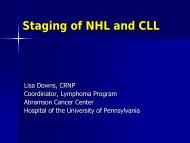
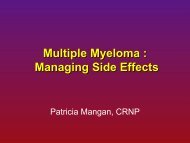

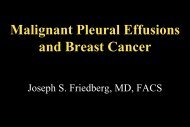

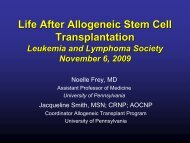
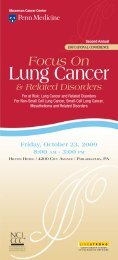
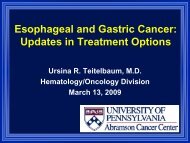
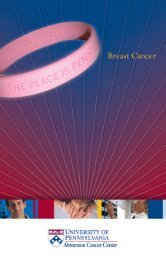
![Agenda [PDF] - Abramson Cancer Center](https://img.yumpu.com/35341208/1/190x245/agenda-pdf-abramson-cancer-center.jpg?quality=85)
